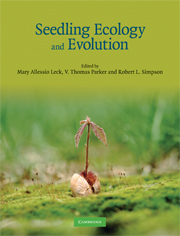Book contents
- Frontmatter
- Contents
- Contributors
- Foreword by Peter J. Grubb
- Preface
- Acknowledgments
- Part I Introduction
- Part II Seedling diversity
- Part III Seedling morphology, evolution, and physiology
- Part IV Life history implications
- Part V Applications
- Chapter 14 Does seedling ecology matter for biological invasions?
- Chapter 15 The role of seedlings in the dynamics of dryland ecosystems – their response to and involvement in dryland heterogeneity, degradation, and restoration
- Chapter 16 Anthropogenic disturbance in tropical forests: toward a functional understanding of seedling responses
- Chapter 17 Seedling establishment in restored ecosystems
- Part VI Synthesis
- References
- Index
Chapter 15 - The role of seedlings in the dynamics of dryland ecosystems – their response to and involvement in dryland heterogeneity, degradation, and restoration
Published online by Cambridge University Press: 05 June 2012
- Frontmatter
- Contents
- Contributors
- Foreword by Peter J. Grubb
- Preface
- Acknowledgments
- Part I Introduction
- Part II Seedling diversity
- Part III Seedling morphology, evolution, and physiology
- Part IV Life history implications
- Part V Applications
- Chapter 14 Does seedling ecology matter for biological invasions?
- Chapter 15 The role of seedlings in the dynamics of dryland ecosystems – their response to and involvement in dryland heterogeneity, degradation, and restoration
- Chapter 16 Anthropogenic disturbance in tropical forests: toward a functional understanding of seedling responses
- Chapter 17 Seedling establishment in restored ecosystems
- Part VI Synthesis
- References
- Index
Summary
Introduction
To understand the role of seedlings in the dynamics of dryland ecosystems, I consider functions seedlings fulfill in population and community dynamics of desert plants and how these functions affect ecosystem and landscape processes. My main focus is to explore the interactions of seedlings with the structure and function of dryland ecosystems. These include not only the responses of seedlings to changes in their environment, but especially their roles in formation and maintenance of spatial heterogeneity and its degradation. These interactions are also involved in sustainable management of arid and semiarid rangeland and in restoration of landscapes degraded by unsustainable human land use. Understanding the roles that plants in general, and seedlings in particular, play in dryland ecosystem and landscape processes may help in formulating appropriate management and restoration methods for sustainable dryland land use under changing climatic conditions.
Interactions involving seedlings are complex and diverse, concerning both pure ecosystem processes, such as resource dynamics of energy, water, nutrients, and gas flows and fluxes, foodweb relations, and the dynamics of the substrate within which the processes occur, that is, the landscape. Part of the complexity arises from the interrelations between ecosystem functions and landscape structure at various spatial and temporal scales. This is strikingly illustrated by the nature of dryland ecosystems, which are characterized by the temporal variability of resources due to scarce pulses of rainfall and by the spatial heterogeneity of the landscape. Both vary from modest in semiarid areas to extreme in hyperarid zones.
- Type
- Chapter
- Information
- Seedling Ecology and Evolution , pp. 307 - 331Publisher: Cambridge University PressPrint publication year: 2008
- 5
- Cited by



